Types of Air Contaminants and Control Measures at Acme Manufacturing Co.
VerifiedAdded on 2023/06/09
|15
|2683
|427
AI Summary
This study examines the problems associated with exposure to air contaminants at Acme Manufacturing Co., provides control measures, and makes recommendations based on the findings of the study. The study found that employees at Acme Manufacturing Co. are exposed to various particulates in the work place which are harmful to their health. Some of the air contaminants in the organization include ozone gas, particulate matter, and benzene. The study recommends more ventilation be provided so as to remove excess moisture in the work place and the use of engineering control measures to minimize or get rid of certain work place hazards.
Contribute Materials
Your contribution can guide someone’s learning journey. Share your
documents today.
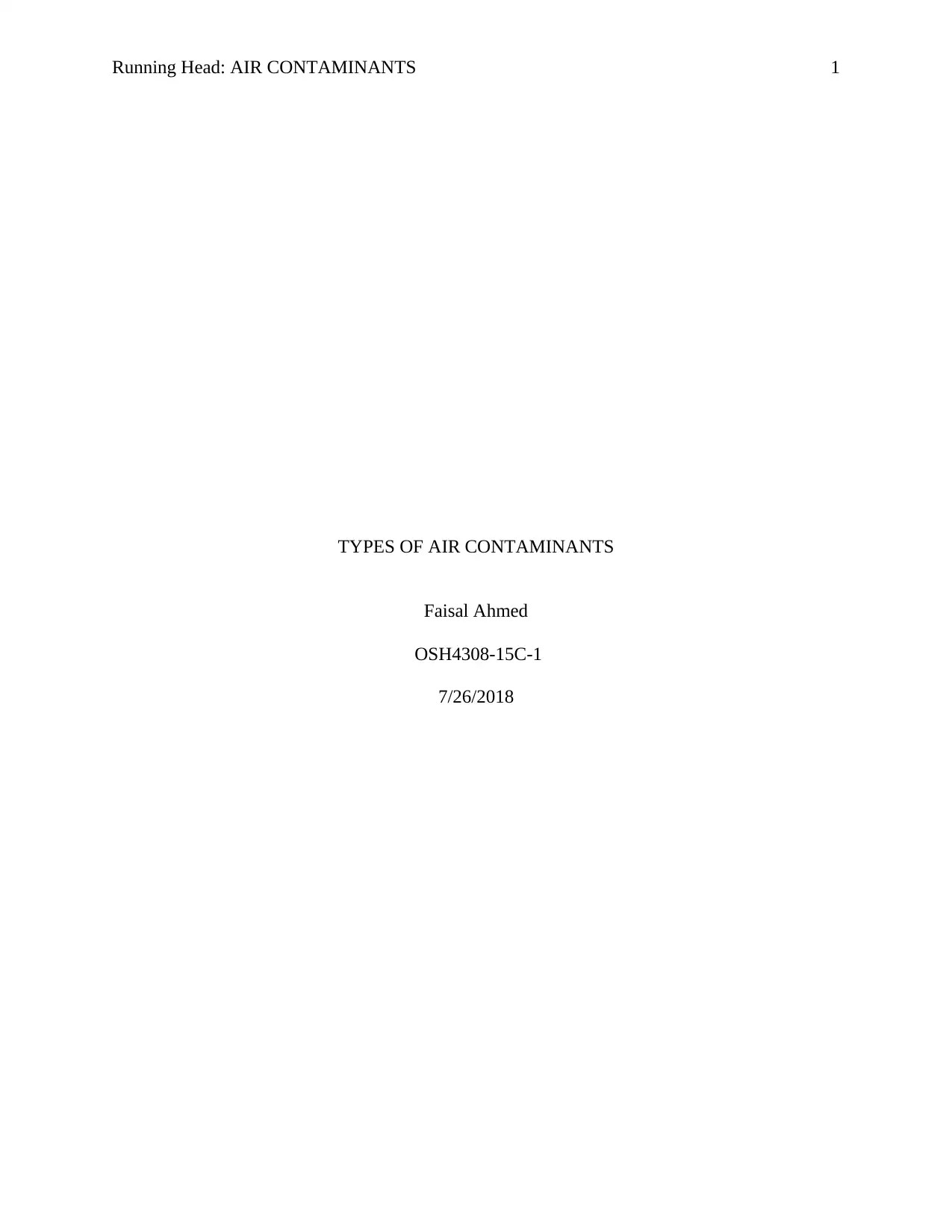
Running Head: AIR CONTAMINANTS 1
TYPES OF AIR CONTAMINANTS
Faisal Ahmed
OSH4308-15C-1
7/26/2018
TYPES OF AIR CONTAMINANTS
Faisal Ahmed
OSH4308-15C-1
7/26/2018
Secure Best Marks with AI Grader
Need help grading? Try our AI Grader for instant feedback on your assignments.

TYPES OF AIR CONTAMINANTS 3
Air Contaminants
Introduction
Studies by Shafie, Kamar & Kamsah (2016) have defined air contaminants refer to gases,
liquids and particles that are present in the air and contain chemical properties that are dangerous
to human health. Most employees are exposed to these air contaminants at their work places
which pose greater risks to their health and also affect their daily performances. This study
therefore aims at examining the problems associated with exposure to air contaminants at Acme
Manufacturing Co., provide control measures, draw conclusions and make recommendations
based on the findings of the study.
Report Details
The study undertook computations for the respective booths to establish the various
elements of the air contaminants in the organization. Through the detailed computations, the
research found that employees at Acme Manufacturing Co. are exposed to various particulates in
the work place which are harmful to their health. This is as a result of among others the
inadequate or poor supply of air in the working environment which raises the concentration of
indoor impurities due to very poor ventilation in the work place. Some of the air contaminants in
the organization include:
Ozone Gas
According to Tan Lim & Mat Jafri (2014), the ozone gas is a gas that can neither be seen
nor be smelt and it naturally occurs over twenty miles higher in the earth surface. The layer
Air Contaminants
Introduction
Studies by Shafie, Kamar & Kamsah (2016) have defined air contaminants refer to gases,
liquids and particles that are present in the air and contain chemical properties that are dangerous
to human health. Most employees are exposed to these air contaminants at their work places
which pose greater risks to their health and also affect their daily performances. This study
therefore aims at examining the problems associated with exposure to air contaminants at Acme
Manufacturing Co., provide control measures, draw conclusions and make recommendations
based on the findings of the study.
Report Details
The study undertook computations for the respective booths to establish the various
elements of the air contaminants in the organization. Through the detailed computations, the
research found that employees at Acme Manufacturing Co. are exposed to various particulates in
the work place which are harmful to their health. This is as a result of among others the
inadequate or poor supply of air in the working environment which raises the concentration of
indoor impurities due to very poor ventilation in the work place. Some of the air contaminants in
the organization include:
Ozone Gas
According to Tan Lim & Mat Jafri (2014), the ozone gas is a gas that can neither be seen
nor be smelt and it naturally occurs over twenty miles higher in the earth surface. The layer
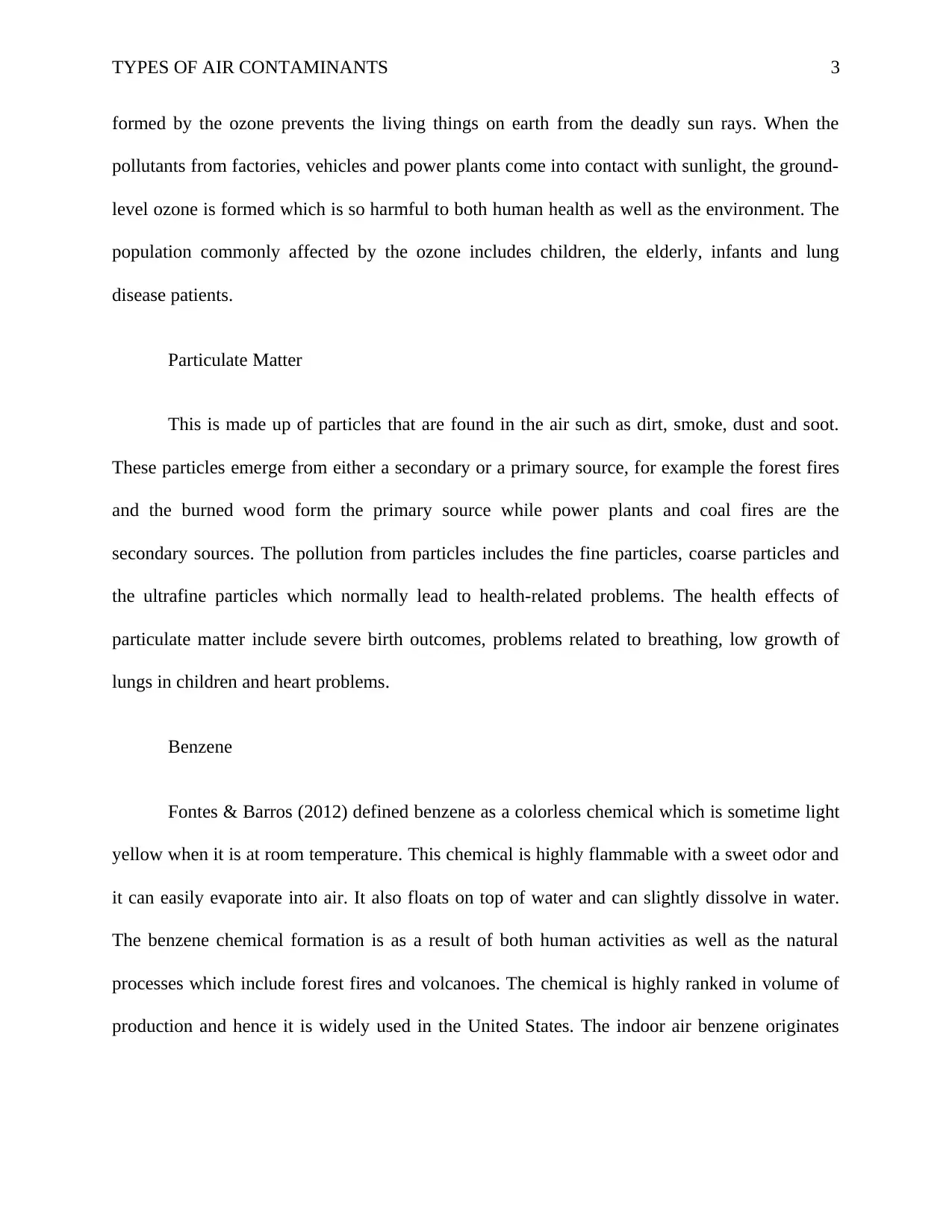
TYPES OF AIR CONTAMINANTS 3
formed by the ozone prevents the living things on earth from the deadly sun rays. When the
pollutants from factories, vehicles and power plants come into contact with sunlight, the ground-
level ozone is formed which is so harmful to both human health as well as the environment. The
population commonly affected by the ozone includes children, the elderly, infants and lung
disease patients.
Particulate Matter
This is made up of particles that are found in the air such as dirt, smoke, dust and soot.
These particles emerge from either a secondary or a primary source, for example the forest fires
and the burned wood form the primary source while power plants and coal fires are the
secondary sources. The pollution from particles includes the fine particles, coarse particles and
the ultrafine particles which normally lead to health-related problems. The health effects of
particulate matter include severe birth outcomes, problems related to breathing, low growth of
lungs in children and heart problems.
Benzene
Fontes & Barros (2012) defined benzene as a colorless chemical which is sometime light
yellow when it is at room temperature. This chemical is highly flammable with a sweet odor and
it can easily evaporate into air. It also floats on top of water and can slightly dissolve in water.
The benzene chemical formation is as a result of both human activities as well as the natural
processes which include forest fires and volcanoes. The chemical is highly ranked in volume of
production and hence it is widely used in the United States. The indoor air benzene originates
formed by the ozone prevents the living things on earth from the deadly sun rays. When the
pollutants from factories, vehicles and power plants come into contact with sunlight, the ground-
level ozone is formed which is so harmful to both human health as well as the environment. The
population commonly affected by the ozone includes children, the elderly, infants and lung
disease patients.
Particulate Matter
This is made up of particles that are found in the air such as dirt, smoke, dust and soot.
These particles emerge from either a secondary or a primary source, for example the forest fires
and the burned wood form the primary source while power plants and coal fires are the
secondary sources. The pollution from particles includes the fine particles, coarse particles and
the ultrafine particles which normally lead to health-related problems. The health effects of
particulate matter include severe birth outcomes, problems related to breathing, low growth of
lungs in children and heart problems.
Benzene
Fontes & Barros (2012) defined benzene as a colorless chemical which is sometime light
yellow when it is at room temperature. This chemical is highly flammable with a sweet odor and
it can easily evaporate into air. It also floats on top of water and can slightly dissolve in water.
The benzene chemical formation is as a result of both human activities as well as the natural
processes which include forest fires and volcanoes. The chemical is highly ranked in volume of
production and hence it is widely used in the United States. The indoor air benzene originates

TYPES OF AIR CONTAMINANTS 3
from benzene products which include detergents, glues, paints and furniture wax while the
outdoor air comes from motor vehicle exhaust, gas stations and tobacco smoke.
Conclusion
The study established that employees at Acme Manufacturing Co. were at higher risk of
inhaling contaminated air especially at their places of work. This is mainly due to ignorance by
the employers to install the necessary and modern equipment for handling such cases. The
exposure poses great health related risks and illness to the employees. It was also found that the
working environment do not have adequate ventilation which exposes workers to various
particulates. The available exhaustion systems were too old and outdated hence inefficient in
ensuring proper supply of air in the working environment.
Recommendation
It is therefore recommended that more ventilation be provided so as to remove excess
moisture in the work place. This can be done by insulating the internal walls for them to become
warmer hence making the internal surface to be dry and mold free. Good ventilation can also be
achieved using a combination of simple air exhaust systems and external air inlets. The exhaust
system is a ventilating system that supplies fresh air at adequate quantity. The system extracts
humid air in the living rooms and draws in fresh air. The modern and most efficient ventilation
units are desirable since they have high heat recovery rates and uses little amount of electricity.
They also contribute to improved quality of air in circulation and therefore no occurrence of
mold growth. Below is a detailed analysis of the same:
from benzene products which include detergents, glues, paints and furniture wax while the
outdoor air comes from motor vehicle exhaust, gas stations and tobacco smoke.
Conclusion
The study established that employees at Acme Manufacturing Co. were at higher risk of
inhaling contaminated air especially at their places of work. This is mainly due to ignorance by
the employers to install the necessary and modern equipment for handling such cases. The
exposure poses great health related risks and illness to the employees. It was also found that the
working environment do not have adequate ventilation which exposes workers to various
particulates. The available exhaustion systems were too old and outdated hence inefficient in
ensuring proper supply of air in the working environment.
Recommendation
It is therefore recommended that more ventilation be provided so as to remove excess
moisture in the work place. This can be done by insulating the internal walls for them to become
warmer hence making the internal surface to be dry and mold free. Good ventilation can also be
achieved using a combination of simple air exhaust systems and external air inlets. The exhaust
system is a ventilating system that supplies fresh air at adequate quantity. The system extracts
humid air in the living rooms and draws in fresh air. The modern and most efficient ventilation
units are desirable since they have high heat recovery rates and uses little amount of electricity.
They also contribute to improved quality of air in circulation and therefore no occurrence of
mold growth. Below is a detailed analysis of the same:
Paraphrase This Document
Need a fresh take? Get an instant paraphrase of this document with our AI Paraphraser
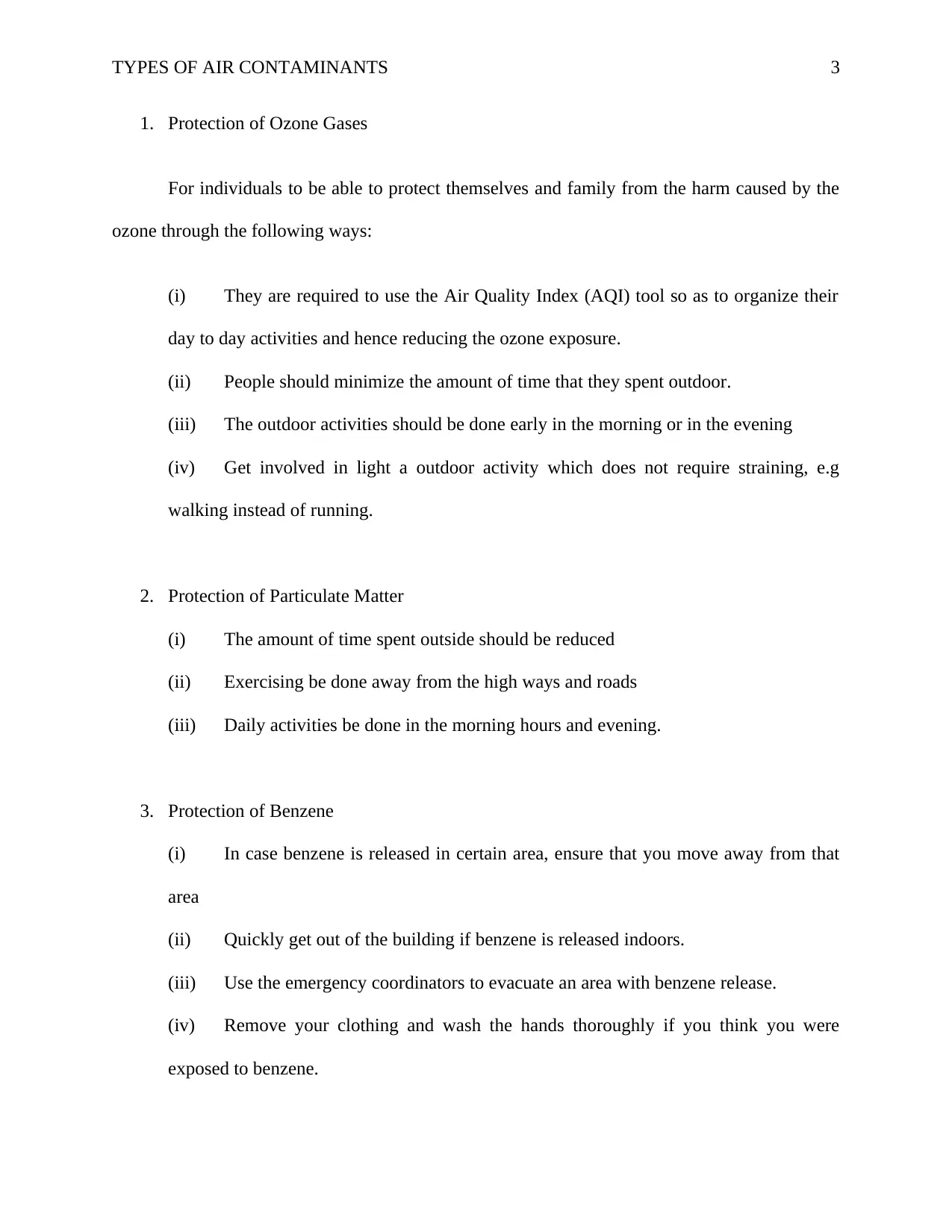
TYPES OF AIR CONTAMINANTS 3
1. Protection of Ozone Gases
For individuals to be able to protect themselves and family from the harm caused by the
ozone through the following ways:
(i) They are required to use the Air Quality Index (AQI) tool so as to organize their
day to day activities and hence reducing the ozone exposure.
(ii) People should minimize the amount of time that they spent outdoor.
(iii) The outdoor activities should be done early in the morning or in the evening
(iv) Get involved in light a outdoor activity which does not require straining, e.g
walking instead of running.
2. Protection of Particulate Matter
(i) The amount of time spent outside should be reduced
(ii) Exercising be done away from the high ways and roads
(iii) Daily activities be done in the morning hours and evening.
3. Protection of Benzene
(i) In case benzene is released in certain area, ensure that you move away from that
area
(ii) Quickly get out of the building if benzene is released indoors.
(iii) Use the emergency coordinators to evacuate an area with benzene release.
(iv) Remove your clothing and wash the hands thoroughly if you think you were
exposed to benzene.
1. Protection of Ozone Gases
For individuals to be able to protect themselves and family from the harm caused by the
ozone through the following ways:
(i) They are required to use the Air Quality Index (AQI) tool so as to organize their
day to day activities and hence reducing the ozone exposure.
(ii) People should minimize the amount of time that they spent outdoor.
(iii) The outdoor activities should be done early in the morning or in the evening
(iv) Get involved in light a outdoor activity which does not require straining, e.g
walking instead of running.
2. Protection of Particulate Matter
(i) The amount of time spent outside should be reduced
(ii) Exercising be done away from the high ways and roads
(iii) Daily activities be done in the morning hours and evening.
3. Protection of Benzene
(i) In case benzene is released in certain area, ensure that you move away from that
area
(ii) Quickly get out of the building if benzene is released indoors.
(iii) Use the emergency coordinators to evacuate an area with benzene release.
(iv) Remove your clothing and wash the hands thoroughly if you think you were
exposed to benzene.
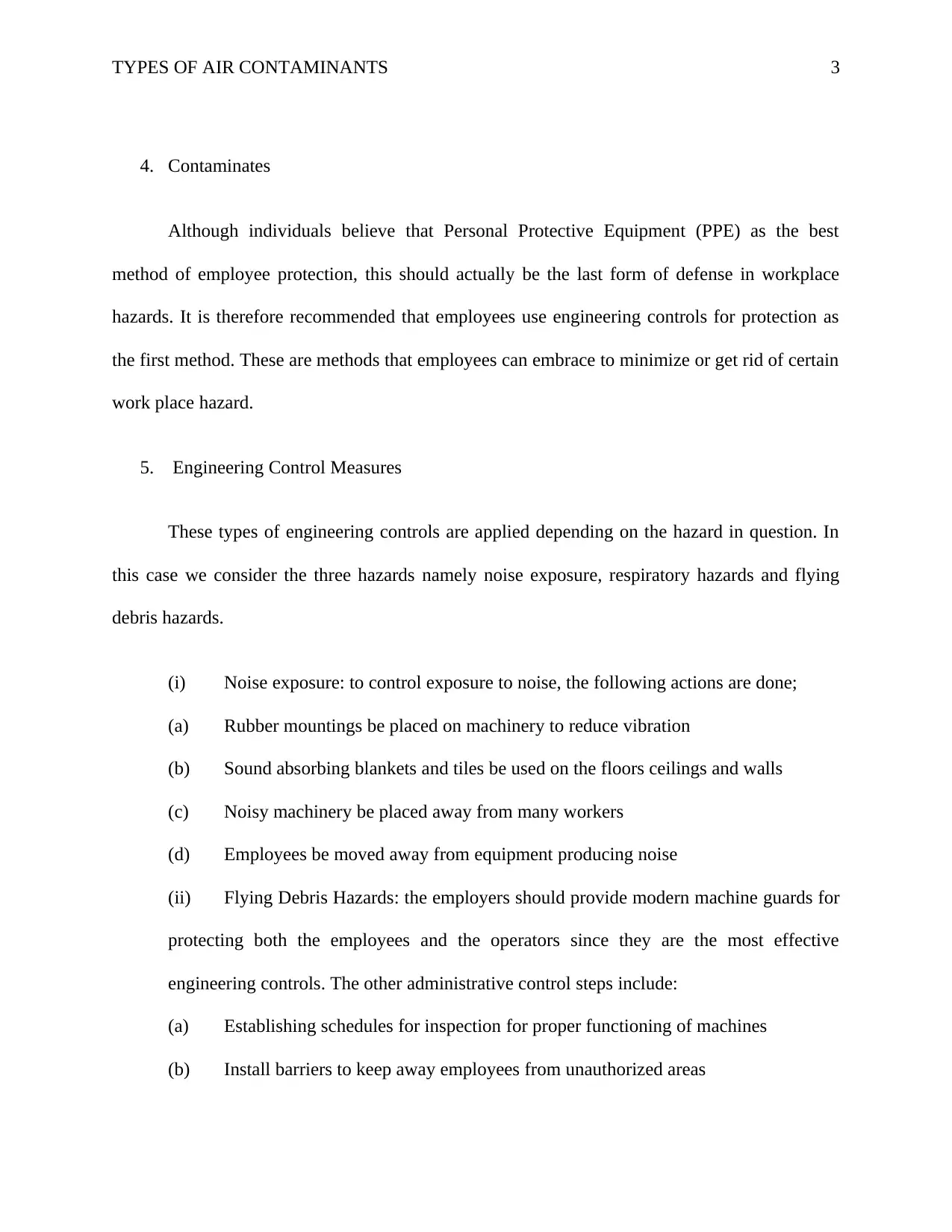
TYPES OF AIR CONTAMINANTS 3
4. Contaminates
Although individuals believe that Personal Protective Equipment (PPE) as the best
method of employee protection, this should actually be the last form of defense in workplace
hazards. It is therefore recommended that employees use engineering controls for protection as
the first method. These are methods that employees can embrace to minimize or get rid of certain
work place hazard.
5. Engineering Control Measures
These types of engineering controls are applied depending on the hazard in question. In
this case we consider the three hazards namely noise exposure, respiratory hazards and flying
debris hazards.
(i) Noise exposure: to control exposure to noise, the following actions are done;
(a) Rubber mountings be placed on machinery to reduce vibration
(b) Sound absorbing blankets and tiles be used on the floors ceilings and walls
(c) Noisy machinery be placed away from many workers
(d) Employees be moved away from equipment producing noise
(ii) Flying Debris Hazards: the employers should provide modern machine guards for
protecting both the employees and the operators since they are the most effective
engineering controls. The other administrative control steps include:
(a) Establishing schedules for inspection for proper functioning of machines
(b) Install barriers to keep away employees from unauthorized areas
4. Contaminates
Although individuals believe that Personal Protective Equipment (PPE) as the best
method of employee protection, this should actually be the last form of defense in workplace
hazards. It is therefore recommended that employees use engineering controls for protection as
the first method. These are methods that employees can embrace to minimize or get rid of certain
work place hazard.
5. Engineering Control Measures
These types of engineering controls are applied depending on the hazard in question. In
this case we consider the three hazards namely noise exposure, respiratory hazards and flying
debris hazards.
(i) Noise exposure: to control exposure to noise, the following actions are done;
(a) Rubber mountings be placed on machinery to reduce vibration
(b) Sound absorbing blankets and tiles be used on the floors ceilings and walls
(c) Noisy machinery be placed away from many workers
(d) Employees be moved away from equipment producing noise
(ii) Flying Debris Hazards: the employers should provide modern machine guards for
protecting both the employees and the operators since they are the most effective
engineering controls. The other administrative control steps include:
(a) Establishing schedules for inspection for proper functioning of machines
(b) Install barriers to keep away employees from unauthorized areas
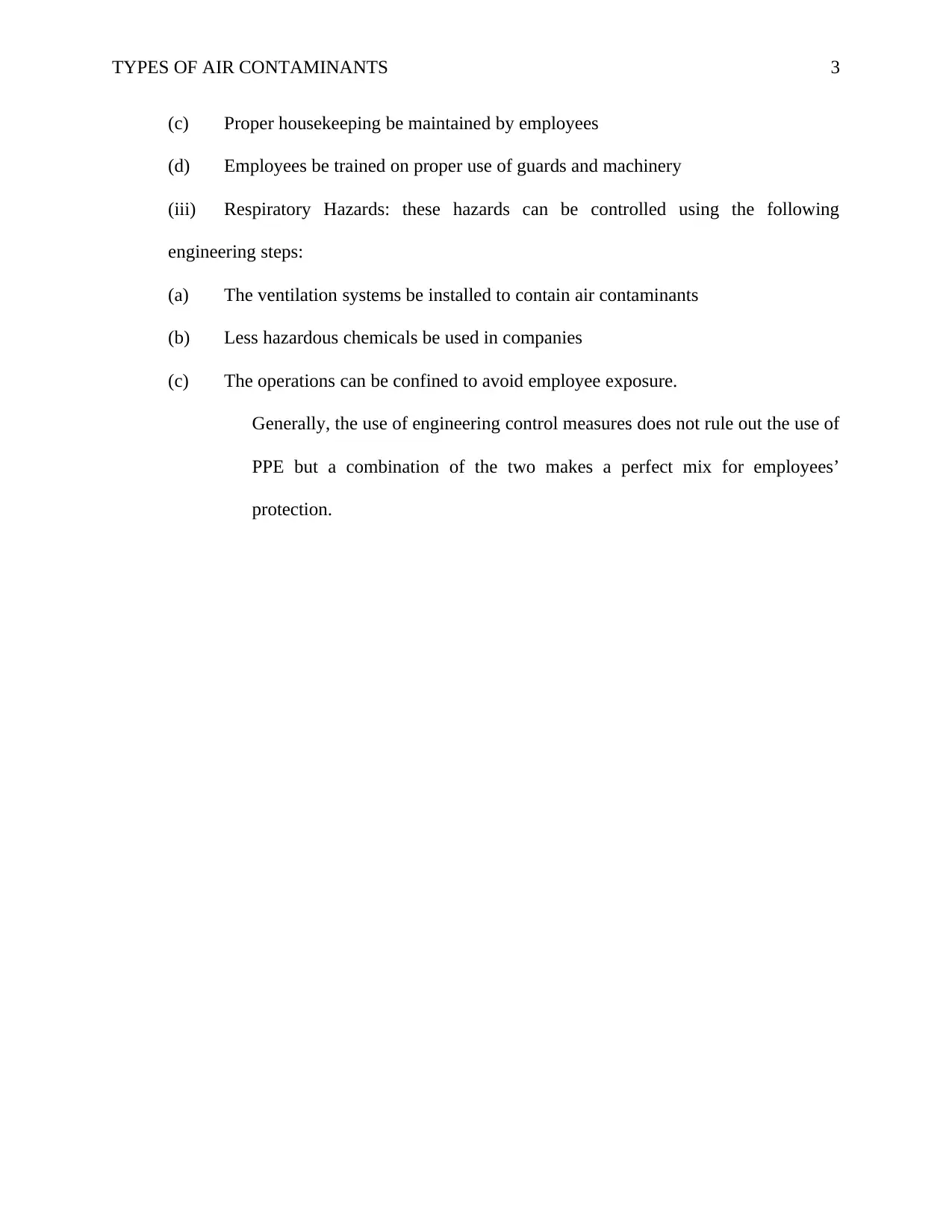
TYPES OF AIR CONTAMINANTS 3
(c) Proper housekeeping be maintained by employees
(d) Employees be trained on proper use of guards and machinery
(iii) Respiratory Hazards: these hazards can be controlled using the following
engineering steps:
(a) The ventilation systems be installed to contain air contaminants
(b) Less hazardous chemicals be used in companies
(c) The operations can be confined to avoid employee exposure.
Generally, the use of engineering control measures does not rule out the use of
PPE but a combination of the two makes a perfect mix for employees’
protection.
(c) Proper housekeeping be maintained by employees
(d) Employees be trained on proper use of guards and machinery
(iii) Respiratory Hazards: these hazards can be controlled using the following
engineering steps:
(a) The ventilation systems be installed to contain air contaminants
(b) Less hazardous chemicals be used in companies
(c) The operations can be confined to avoid employee exposure.
Generally, the use of engineering control measures does not rule out the use of
PPE but a combination of the two makes a perfect mix for employees’
protection.
Secure Best Marks with AI Grader
Need help grading? Try our AI Grader for instant feedback on your assignments.
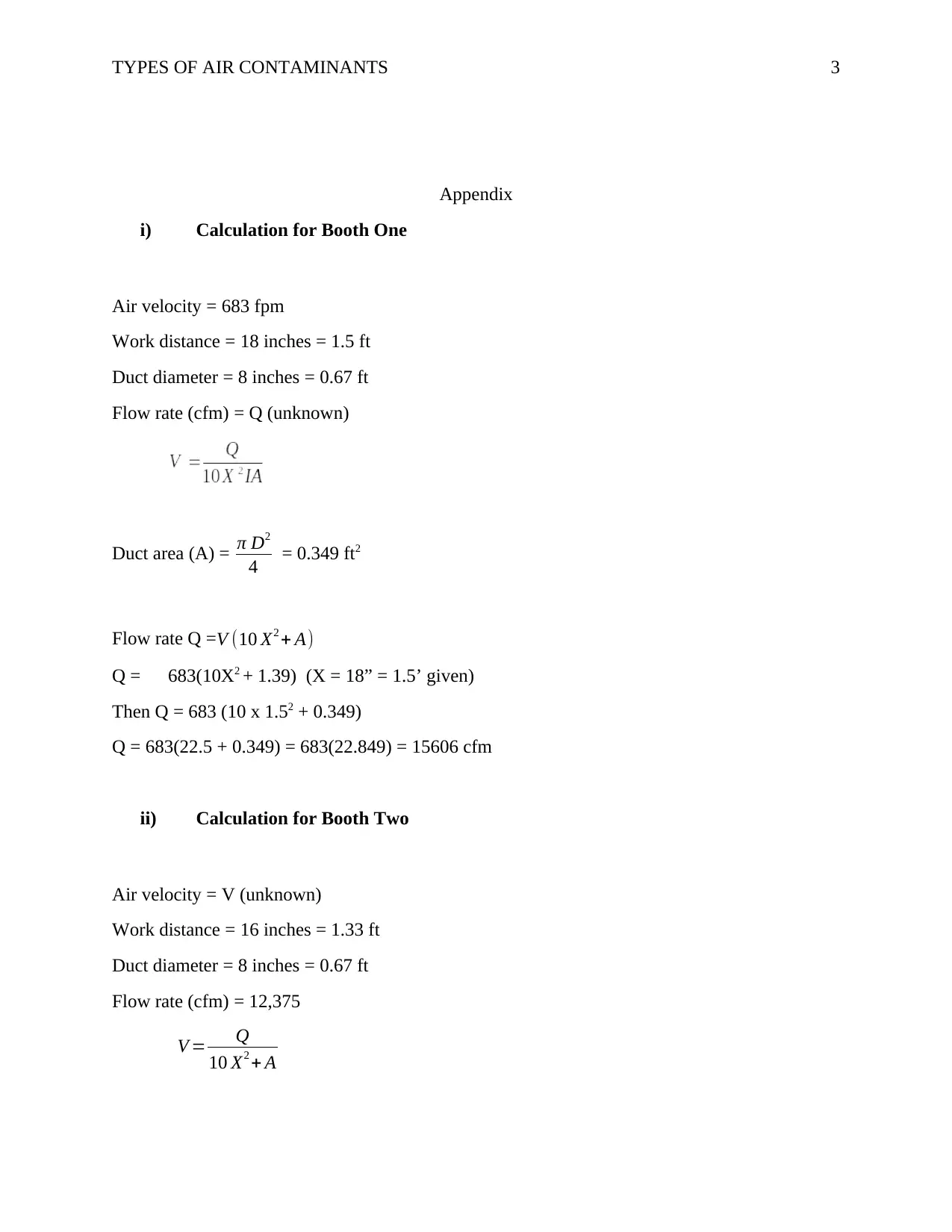
TYPES OF AIR CONTAMINANTS 3
Appendix
i) Calculation for Booth One
Air velocity = 683 fpm
Work distance = 18 inches = 1.5 ft
Duct diameter = 8 inches = 0.67 ft
Flow rate (cfm) = Q (unknown)
Duct area (A) = π D2
4 = 0.349 ft2
Flow rate Q =V (10 X2 + A)
Q = 683(10X2 + 1.39) (X = 18” = 1.5’ given)
Then Q = 683 (10 x 1.52 + 0.349)
Q = 683(22.5 + 0.349) = 683(22.849) = 15606 cfm
ii) Calculation for Booth Two
Air velocity = V (unknown)
Work distance = 16 inches = 1.33 ft
Duct diameter = 8 inches = 0.67 ft
Flow rate (cfm) = 12,375
V = Q
10 X2 + A
Appendix
i) Calculation for Booth One
Air velocity = 683 fpm
Work distance = 18 inches = 1.5 ft
Duct diameter = 8 inches = 0.67 ft
Flow rate (cfm) = Q (unknown)
Duct area (A) = π D2
4 = 0.349 ft2
Flow rate Q =V (10 X2 + A)
Q = 683(10X2 + 1.39) (X = 18” = 1.5’ given)
Then Q = 683 (10 x 1.52 + 0.349)
Q = 683(22.5 + 0.349) = 683(22.849) = 15606 cfm
ii) Calculation for Booth Two
Air velocity = V (unknown)
Work distance = 16 inches = 1.33 ft
Duct diameter = 8 inches = 0.67 ft
Flow rate (cfm) = 12,375
V = Q
10 X2 + A
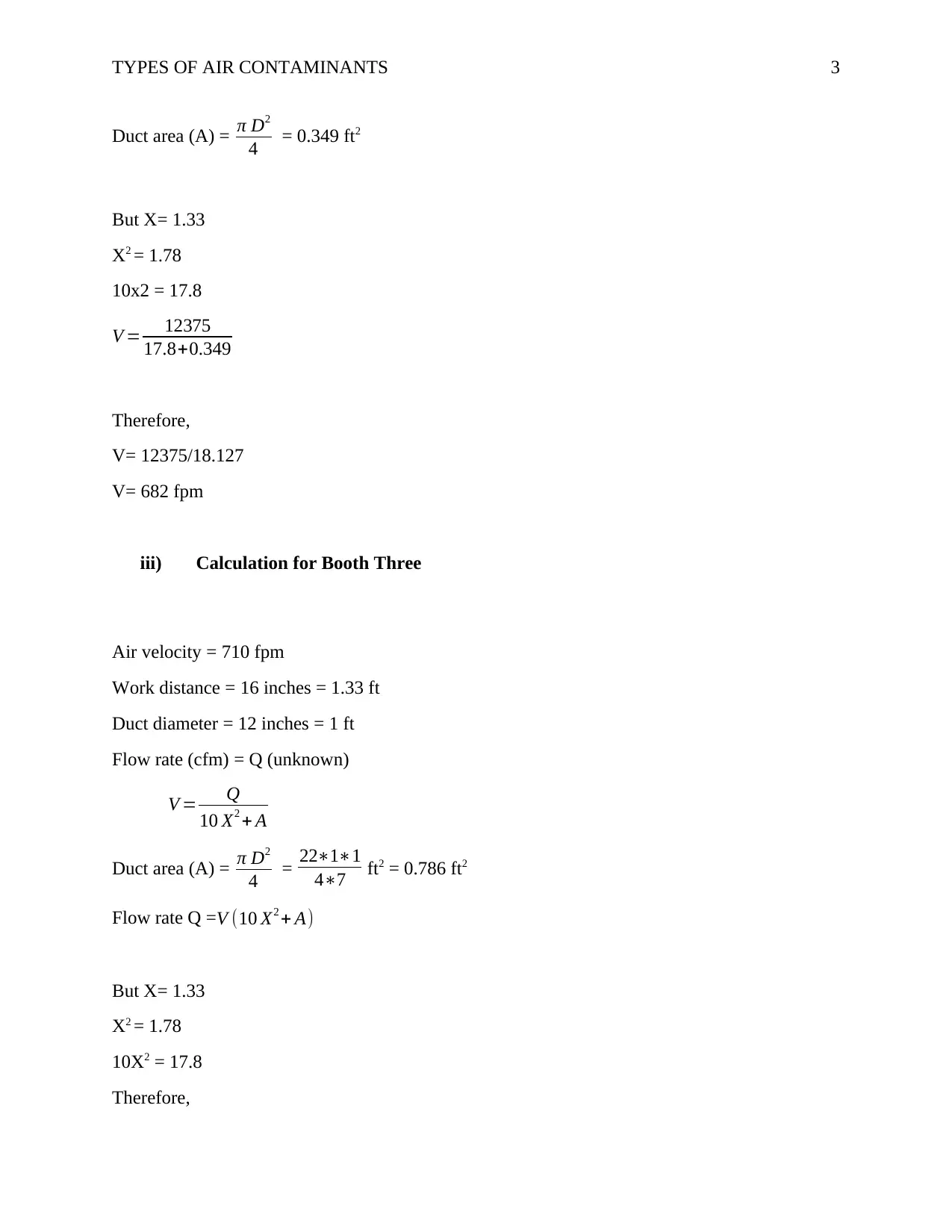
TYPES OF AIR CONTAMINANTS 3
Duct area (A) = π D2
4 = 0.349 ft2
But X= 1.33
X2 = 1.78
10x2 = 17.8
V = 12375
17.8+0.349
Therefore,
V= 12375/18.127
V= 682 fpm
iii) Calculation for Booth Three
Air velocity = 710 fpm
Work distance = 16 inches = 1.33 ft
Duct diameter = 12 inches = 1 ft
Flow rate (cfm) = Q (unknown)
V = Q
10 X2 + A
Duct area (A) = π D2
4 = 22∗1∗1
4∗7 ft2 = 0.786 ft2
Flow rate Q =V (10 X2 + A)
But X= 1.33
X2 = 1.78
10X2 = 17.8
Therefore,
Duct area (A) = π D2
4 = 0.349 ft2
But X= 1.33
X2 = 1.78
10x2 = 17.8
V = 12375
17.8+0.349
Therefore,
V= 12375/18.127
V= 682 fpm
iii) Calculation for Booth Three
Air velocity = 710 fpm
Work distance = 16 inches = 1.33 ft
Duct diameter = 12 inches = 1 ft
Flow rate (cfm) = Q (unknown)
V = Q
10 X2 + A
Duct area (A) = π D2
4 = 22∗1∗1
4∗7 ft2 = 0.786 ft2
Flow rate Q =V (10 X2 + A)
But X= 1.33
X2 = 1.78
10X2 = 17.8
Therefore,

TYPES OF AIR CONTAMINANTS 3
710= Q/{117.8 +0.786}
683= Q/{18.563}
Q = 683/18.563 = 13180.07 cfpm
iv) Calculation for Booth Four
Air velocity = 184 fpm
Work distance = 26 inches = 2.17 ft
Duct diameter = 8 inches = 0.69 ft
Flow rate (cfm) = Q (unknown)
V = Q
10 X2 + A
Duct area (A) = π D2
4 = 22 x .67 x .67
4∗7 ft2 = 0.349 ft2
Q = 184(10X2 + 0.349), (X = 26” = 2.17’ given)
But X= 2.17
X2 = 4.704
10X2 = 446.9
Therefore,
Q = 184(46.9+ 0.349), (X = 26” = 2.17’ given)
Q = 184*47.294
Q = 8702.03 cfmp
v) Booth Five
Air velocity = V (unknown)
710= Q/{117.8 +0.786}
683= Q/{18.563}
Q = 683/18.563 = 13180.07 cfpm
iv) Calculation for Booth Four
Air velocity = 184 fpm
Work distance = 26 inches = 2.17 ft
Duct diameter = 8 inches = 0.69 ft
Flow rate (cfm) = Q (unknown)
V = Q
10 X2 + A
Duct area (A) = π D2
4 = 22 x .67 x .67
4∗7 ft2 = 0.349 ft2
Q = 184(10X2 + 0.349), (X = 26” = 2.17’ given)
But X= 2.17
X2 = 4.704
10X2 = 446.9
Therefore,
Q = 184(46.9+ 0.349), (X = 26” = 2.17’ given)
Q = 184*47.294
Q = 8702.03 cfmp
v) Booth Five
Air velocity = V (unknown)
Paraphrase This Document
Need a fresh take? Get an instant paraphrase of this document with our AI Paraphraser
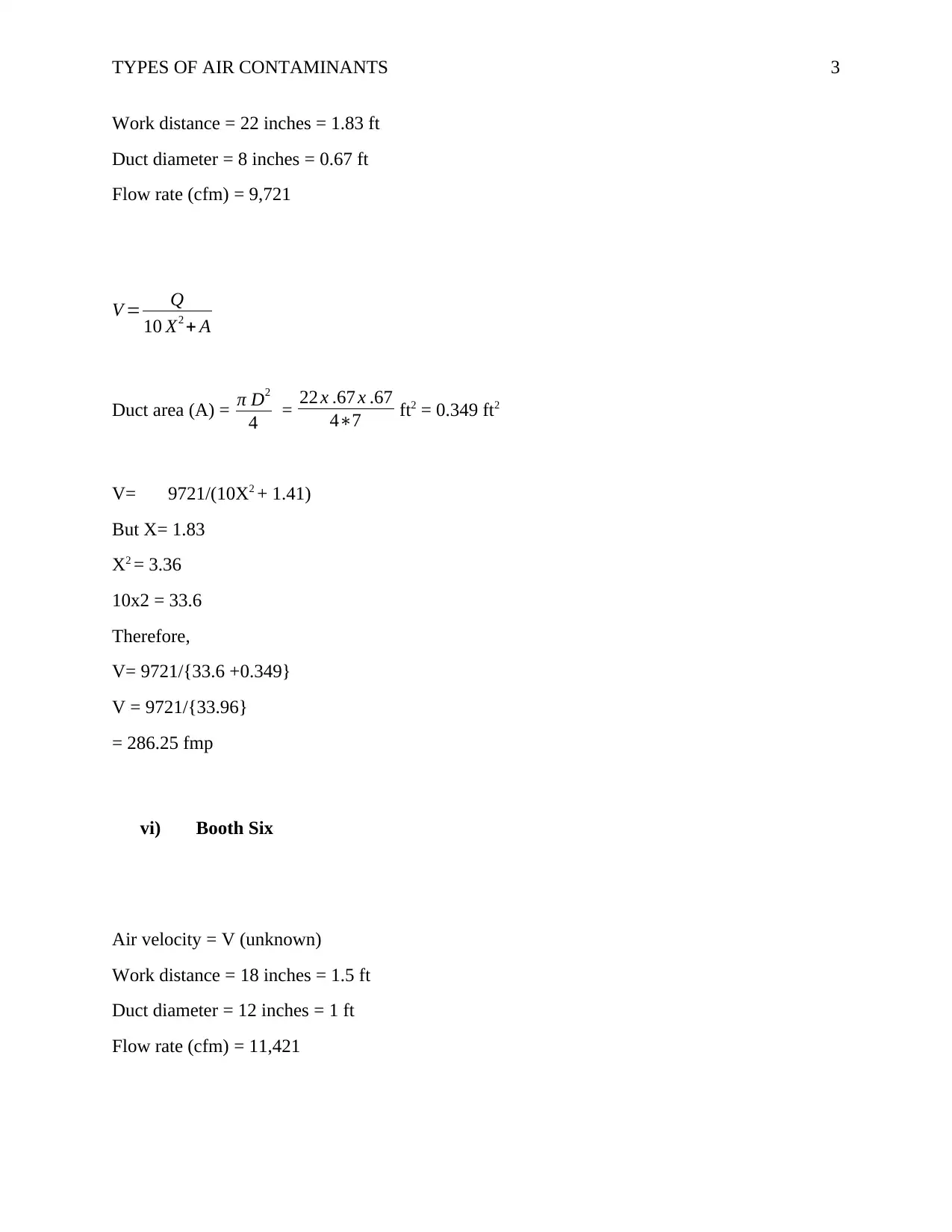
TYPES OF AIR CONTAMINANTS 3
Work distance = 22 inches = 1.83 ft
Duct diameter = 8 inches = 0.67 ft
Flow rate (cfm) = 9,721
V = Q
10 X2 + A
Duct area (A) = π D2
4 = 22 x .67 x .67
4∗7 ft2 = 0.349 ft2
V= 9721/(10X2 + 1.41)
But X= 1.83
X2 = 3.36
10x2 = 33.6
Therefore,
V= 9721/{33.6 +0.349}
V = 9721/{33.96}
= 286.25 fmp
vi) Booth Six
Air velocity = V (unknown)
Work distance = 18 inches = 1.5 ft
Duct diameter = 12 inches = 1 ft
Flow rate (cfm) = 11,421
Work distance = 22 inches = 1.83 ft
Duct diameter = 8 inches = 0.67 ft
Flow rate (cfm) = 9,721
V = Q
10 X2 + A
Duct area (A) = π D2
4 = 22 x .67 x .67
4∗7 ft2 = 0.349 ft2
V= 9721/(10X2 + 1.41)
But X= 1.83
X2 = 3.36
10x2 = 33.6
Therefore,
V= 9721/{33.6 +0.349}
V = 9721/{33.96}
= 286.25 fmp
vi) Booth Six
Air velocity = V (unknown)
Work distance = 18 inches = 1.5 ft
Duct diameter = 12 inches = 1 ft
Flow rate (cfm) = 11,421
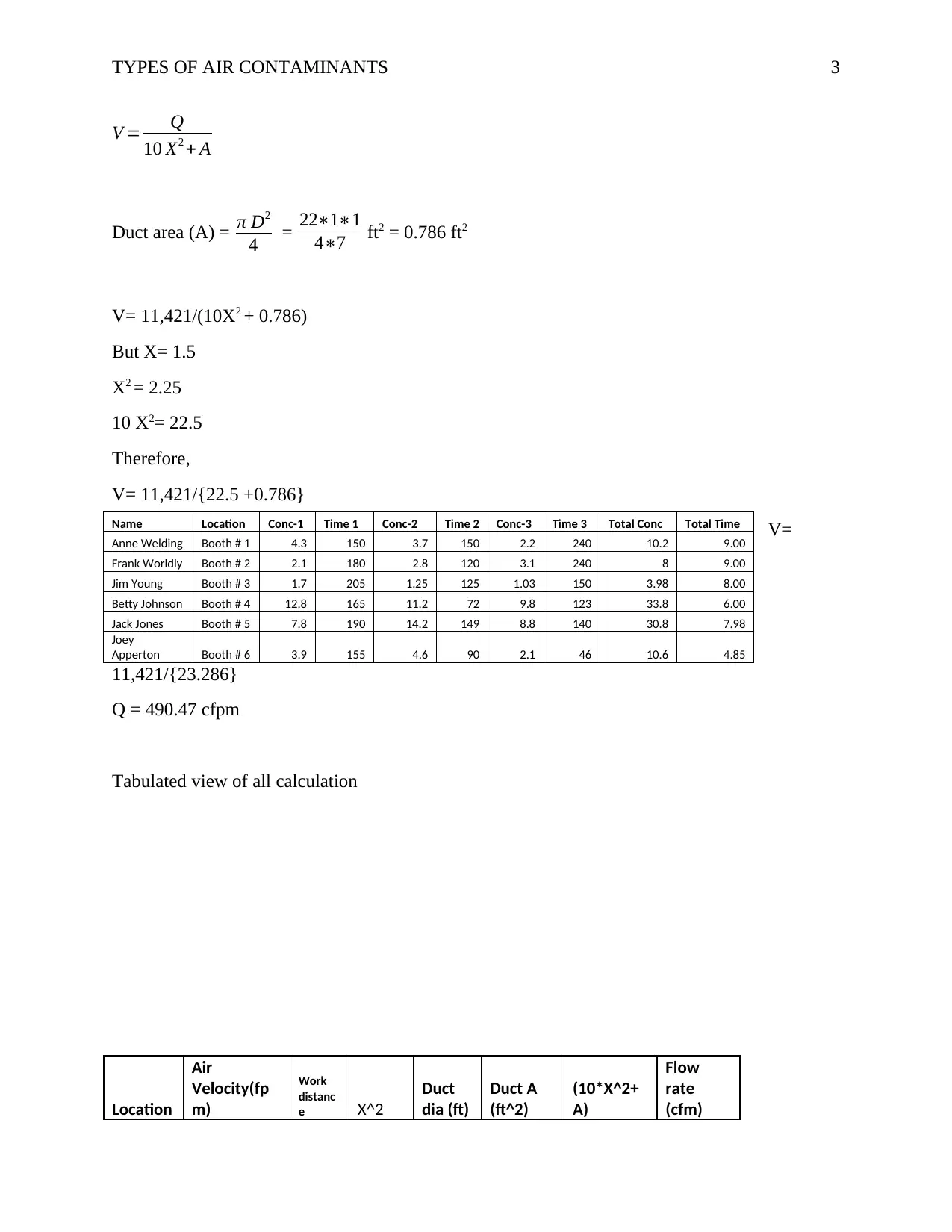
TYPES OF AIR CONTAMINANTS 3
V = Q
10 X2 + A
Duct area (A) = π D2
4 = 22∗1∗1
4∗7 ft2 = 0.786 ft2
V= 11,421/(10X2 + 0.786)
But X= 1.5
X2 = 2.25
10 X2= 22.5
Therefore,
V= 11,421/{22.5 +0.786}
V=
11,421/{23.286}
Q = 490.47 cfpm
Tabulated view of all calculation
Location
Air
Velocity(fp
m)
Work
distanc
e X^2
Duct
dia (ft)
Duct A
(ft^2)
(10*X^2+
A)
Flow
rate
(cfm)
Name Location Conc-1 Time 1 Conc-2 Time 2 Conc-3 Time 3 Total Conc Total Time
Anne Welding Booth # 1 4.3 150 3.7 150 2.2 240 10.2 9.00
Frank Worldly Booth # 2 2.1 180 2.8 120 3.1 240 8 9.00
Jim Young Booth # 3 1.7 205 1.25 125 1.03 150 3.98 8.00
Betty Johnson Booth # 4 12.8 165 11.2 72 9.8 123 33.8 6.00
Jack Jones Booth # 5 7.8 190 14.2 149 8.8 140 30.8 7.98
Joey
Apperton Booth # 6 3.9 155 4.6 90 2.1 46 10.6 4.85
V = Q
10 X2 + A
Duct area (A) = π D2
4 = 22∗1∗1
4∗7 ft2 = 0.786 ft2
V= 11,421/(10X2 + 0.786)
But X= 1.5
X2 = 2.25
10 X2= 22.5
Therefore,
V= 11,421/{22.5 +0.786}
V=
11,421/{23.286}
Q = 490.47 cfpm
Tabulated view of all calculation
Location
Air
Velocity(fp
m)
Work
distanc
e X^2
Duct
dia (ft)
Duct A
(ft^2)
(10*X^2+
A)
Flow
rate
(cfm)
Name Location Conc-1 Time 1 Conc-2 Time 2 Conc-3 Time 3 Total Conc Total Time
Anne Welding Booth # 1 4.3 150 3.7 150 2.2 240 10.2 9.00
Frank Worldly Booth # 2 2.1 180 2.8 120 3.1 240 8 9.00
Jim Young Booth # 3 1.7 205 1.25 125 1.03 150 3.98 8.00
Betty Johnson Booth # 4 12.8 165 11.2 72 9.8 123 33.8 6.00
Jack Jones Booth # 5 7.8 190 14.2 149 8.8 140 30.8 7.98
Joey
Apperton Booth # 6 3.9 155 4.6 90 2.1 46 10.6 4.85
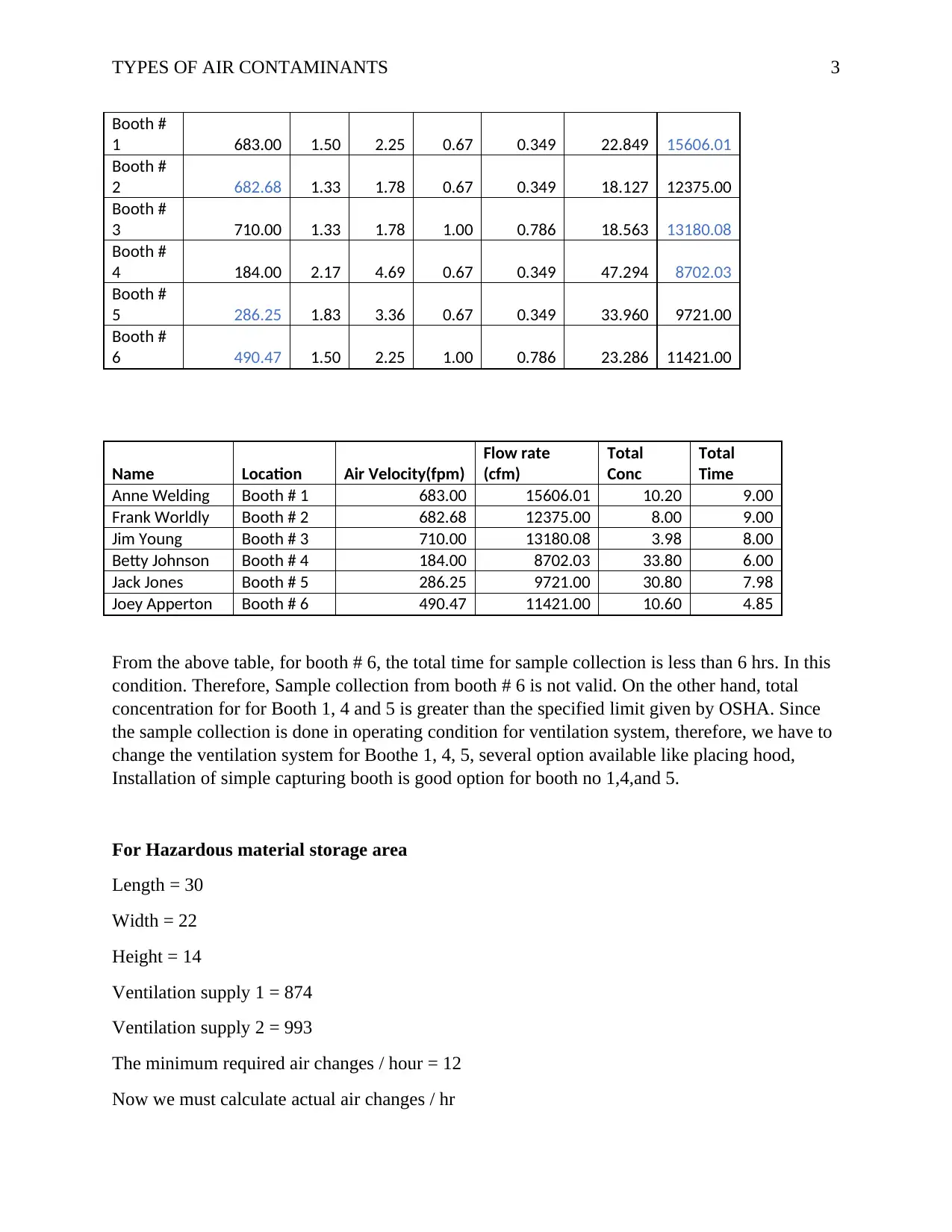
TYPES OF AIR CONTAMINANTS 3
Booth #
1 683.00 1.50 2.25 0.67 0.349 22.849 15606.01
Booth #
2 682.68 1.33 1.78 0.67 0.349 18.127 12375.00
Booth #
3 710.00 1.33 1.78 1.00 0.786 18.563 13180.08
Booth #
4 184.00 2.17 4.69 0.67 0.349 47.294 8702.03
Booth #
5 286.25 1.83 3.36 0.67 0.349 33.960 9721.00
Booth #
6 490.47 1.50 2.25 1.00 0.786 23.286 11421.00
Name Location Air Velocity(fpm)
Flow rate
(cfm)
Total
Conc
Total
Time
Anne Welding Booth # 1 683.00 15606.01 10.20 9.00
Frank Worldly Booth # 2 682.68 12375.00 8.00 9.00
Jim Young Booth # 3 710.00 13180.08 3.98 8.00
Betty Johnson Booth # 4 184.00 8702.03 33.80 6.00
Jack Jones Booth # 5 286.25 9721.00 30.80 7.98
Joey Apperton Booth # 6 490.47 11421.00 10.60 4.85
From the above table, for booth # 6, the total time for sample collection is less than 6 hrs. In this
condition. Therefore, Sample collection from booth # 6 is not valid. On the other hand, total
concentration for for Booth 1, 4 and 5 is greater than the specified limit given by OSHA. Since
the sample collection is done in operating condition for ventilation system, therefore, we have to
change the ventilation system for Boothe 1, 4, 5, several option available like placing hood,
Installation of simple capturing booth is good option for booth no 1,4,and 5.
For Hazardous material storage area
Length = 30
Width = 22
Height = 14
Ventilation supply 1 = 874
Ventilation supply 2 = 993
The minimum required air changes / hour = 12
Now we must calculate actual air changes / hr
Booth #
1 683.00 1.50 2.25 0.67 0.349 22.849 15606.01
Booth #
2 682.68 1.33 1.78 0.67 0.349 18.127 12375.00
Booth #
3 710.00 1.33 1.78 1.00 0.786 18.563 13180.08
Booth #
4 184.00 2.17 4.69 0.67 0.349 47.294 8702.03
Booth #
5 286.25 1.83 3.36 0.67 0.349 33.960 9721.00
Booth #
6 490.47 1.50 2.25 1.00 0.786 23.286 11421.00
Name Location Air Velocity(fpm)
Flow rate
(cfm)
Total
Conc
Total
Time
Anne Welding Booth # 1 683.00 15606.01 10.20 9.00
Frank Worldly Booth # 2 682.68 12375.00 8.00 9.00
Jim Young Booth # 3 710.00 13180.08 3.98 8.00
Betty Johnson Booth # 4 184.00 8702.03 33.80 6.00
Jack Jones Booth # 5 286.25 9721.00 30.80 7.98
Joey Apperton Booth # 6 490.47 11421.00 10.60 4.85
From the above table, for booth # 6, the total time for sample collection is less than 6 hrs. In this
condition. Therefore, Sample collection from booth # 6 is not valid. On the other hand, total
concentration for for Booth 1, 4 and 5 is greater than the specified limit given by OSHA. Since
the sample collection is done in operating condition for ventilation system, therefore, we have to
change the ventilation system for Boothe 1, 4, 5, several option available like placing hood,
Installation of simple capturing booth is good option for booth no 1,4,and 5.
For Hazardous material storage area
Length = 30
Width = 22
Height = 14
Ventilation supply 1 = 874
Ventilation supply 2 = 993
The minimum required air changes / hour = 12
Now we must calculate actual air changes / hr
Secure Best Marks with AI Grader
Need help grading? Try our AI Grader for instant feedback on your assignments.
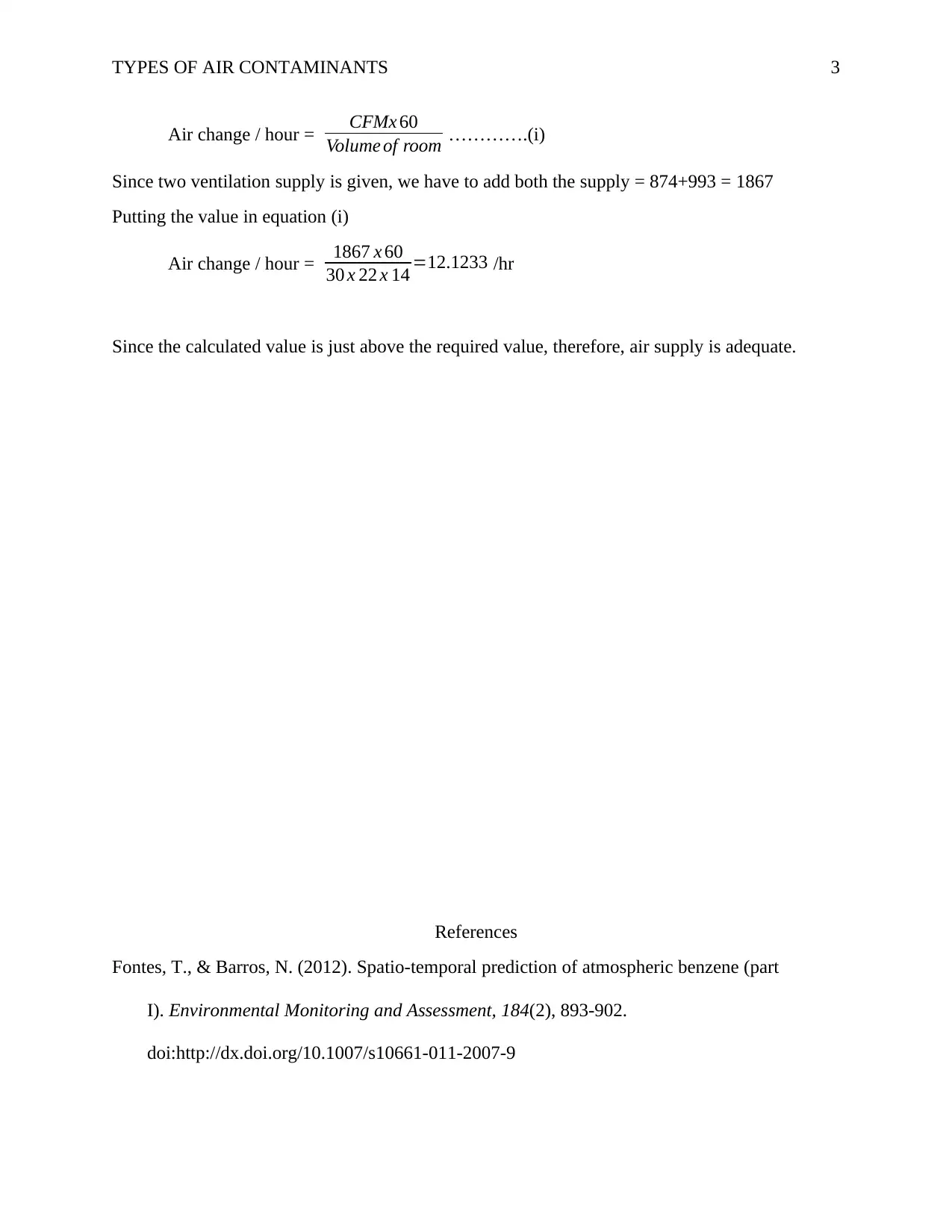
TYPES OF AIR CONTAMINANTS 3
Air change / hour = CFMx 60
Volume of room ………….(i)
Since two ventilation supply is given, we have to add both the supply = 874+993 = 1867
Putting the value in equation (i)
Air change / hour = 1867 x 60
30 x 22 x 14 =12.1233 /hr
Since the calculated value is just above the required value, therefore, air supply is adequate.
References
Fontes, T., & Barros, N. (2012). Spatio-temporal prediction of atmospheric benzene (part
I). Environmental Monitoring and Assessment, 184(2), 893-902.
doi:http://dx.doi.org/10.1007/s10661-011-2007-9
Air change / hour = CFMx 60
Volume of room ………….(i)
Since two ventilation supply is given, we have to add both the supply = 874+993 = 1867
Putting the value in equation (i)
Air change / hour = 1867 x 60
30 x 22 x 14 =12.1233 /hr
Since the calculated value is just above the required value, therefore, air supply is adequate.
References
Fontes, T., & Barros, N. (2012). Spatio-temporal prediction of atmospheric benzene (part
I). Environmental Monitoring and Assessment, 184(2), 893-902.
doi:http://dx.doi.org/10.1007/s10661-011-2007-9
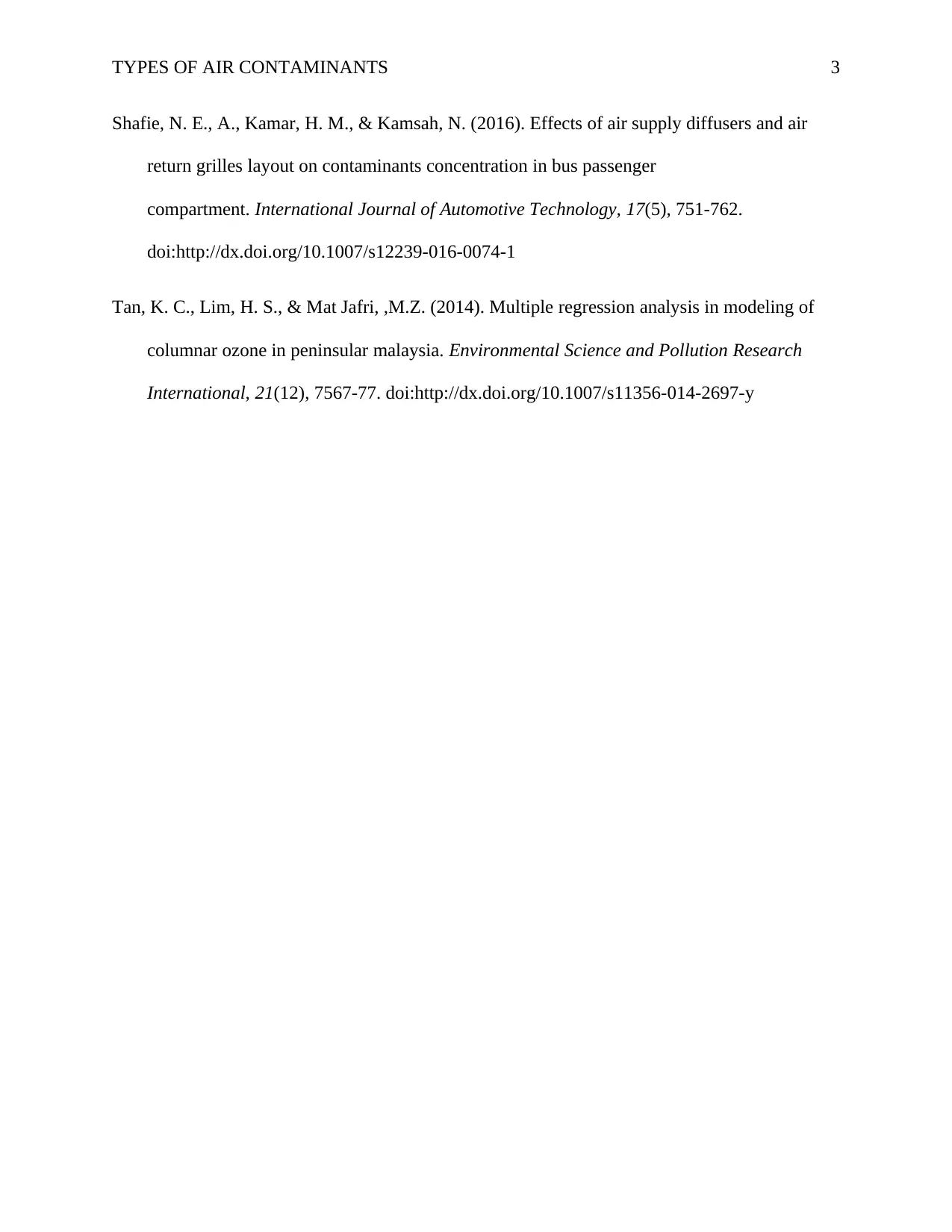
TYPES OF AIR CONTAMINANTS 3
Shafie, N. E., A., Kamar, H. M., & Kamsah, N. (2016). Effects of air supply diffusers and air
return grilles layout on contaminants concentration in bus passenger
compartment. International Journal of Automotive Technology, 17(5), 751-762.
doi:http://dx.doi.org/10.1007/s12239-016-0074-1
Tan, K. C., Lim, H. S., & Mat Jafri, ,M.Z. (2014). Multiple regression analysis in modeling of
columnar ozone in peninsular malaysia. Environmental Science and Pollution Research
International, 21(12), 7567-77. doi:http://dx.doi.org/10.1007/s11356-014-2697-y
Shafie, N. E., A., Kamar, H. M., & Kamsah, N. (2016). Effects of air supply diffusers and air
return grilles layout on contaminants concentration in bus passenger
compartment. International Journal of Automotive Technology, 17(5), 751-762.
doi:http://dx.doi.org/10.1007/s12239-016-0074-1
Tan, K. C., Lim, H. S., & Mat Jafri, ,M.Z. (2014). Multiple regression analysis in modeling of
columnar ozone in peninsular malaysia. Environmental Science and Pollution Research
International, 21(12), 7567-77. doi:http://dx.doi.org/10.1007/s11356-014-2697-y
1 out of 15
Related Documents
Your All-in-One AI-Powered Toolkit for Academic Success.
+13062052269
info@desklib.com
Available 24*7 on WhatsApp / Email
![[object Object]](/_next/static/media/star-bottom.7253800d.svg)
Unlock your academic potential
© 2024 | Zucol Services PVT LTD | All rights reserved.





